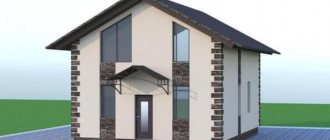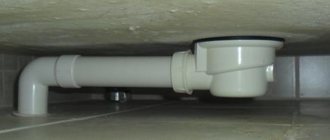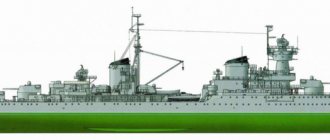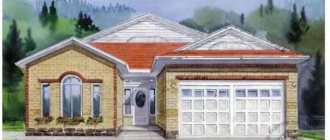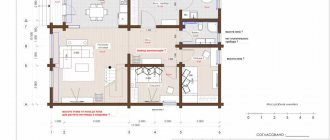72A 3D “Exprofesso” is a unique project that has no analogues
Maxim1919 @ Ataman69
Comrades who have already built on this project, tell me how you installed the engineering systems: in particular gas and water. It just turns out that the boiler room is on one side of the house, and the bathrooms and kitchen are on the other. Who coped with this task?
Ataman69 @ Maxim1919 Pipes for sewerage, cold and hot water were laid in advance in a monolithic slab. Nothing complicated. For example, cold water appeared in my house earlier than the walls, right at the stage of building the foundation.
Koalla @ shlomo-dn Question: Pavel, you are the only one of us who has already done interior decoration. How do you feel, the bathrooms are not cramped, everything fits from the plumbing? Especially in the attic, where there is a sloping ceiling and a window? Or do you want space?
shlomo-dn @ Koalla As I wrote earlier, I enlarged the bathroom in the attic for this purpose. I didn’t change anything on the second and first floors to create a corner bath. besides the fact that there won’t be a shower on the second one, why is it there? When the shower is in the sauna! This makes it very spacious, although there are no bathroom equipment yet!
Evgenia77 Hello, all those in love with project 72)! My husband and I are planning to build a house for our large family, and it’s taking us a painfully long time to decide on both the material and the design. Our budget is modest, the site is small, but our plans are grandiose). We were choosing between the 72nd E project (my choice) and our own project of a house made of cylinders (at the request of my husband)... But the other day, our friends’ house burned down and I, as a mother of 4 children, was very concerned about the issue of fire hazard... So we returned again to this wonderful project. We decided to use brick construction (fortunately, there are good brick factories in Chuvashia). I have questions for everyone who has built from the same material or from warm ceramics. Maybe I’ll repeat the questions (since I haven’t physically mastered all 2 topics yet): * does the actual consumption of bricks coincide with the project estimate?; * in St. Petersburg they told me that the wall was designed in the form of a “pie”: porous brick + insulation + facing brick (plaster). Has anyone built without insulation, for example 2.5 bricks? What was the cost? * Is the technology of laying warm ceramics complicated if you do the laying yourself? * Is it possible to put a ceramic box and leave it without external decoration for the winter? Thanks in advance to everyone who responds! 
AnekV @ Evgenia77 Hello:) We are also from Cheboksary, we are building according to the 72 A project (though with minor changes). I saw the same house built in Grimyachevo. We built from expanded clay concrete blocks + insulation + silicate facing bricks. I really like the house that it looks compact but is quite spacious inside. We haven't finished building yet, we're going to order windows this week. This is what our house looks like now. We made a room instead of a garage.
Koalla Many people choose this project because of its narrow area, this is its highlight. And I don’t understand the burning desire to put two cars in the garage. I personally like the garage for its size. My husband and I agreed a long time ago that we would put shelving on both sides. He even let me paint them different colors. And he most likely will not park the car in the garage at night. It will be left in front of the house, behind closed gates. And in the garage for an alarm system if you need to leave somewhere out of town.
Failed Soviet aircraft carriers: development of Project 72
With the beginning of the Great Patriotic War in the Soviet Union, all work of research and design institutions of the Navy that was not directly related to the direct support of naval combat operations was stopped. Work on the Project 71 light aircraft carrier stopped even earlier - at the beginning of 1940. However, the very idea of strengthening the Soviet fleet with an aircraft-carrying ship was not forgotten...
In 1944, the People's Commissariat of the Shipbuilding Industry prepared a voluminous summary report of a group of shipbuilding engineers sent to the United States. This document described in detail the ship design system and the organizational features of the American shipbuilding industry - right down to the personnel policy of the shipyards. Among other appendices to the report there was a 55-page “Description of the escort aircraft carrier and landing craft.” In addition, on March 25, 1944, the head of the 1st department of the Navy Shipbuilding Directorate, engineer-captain 2nd rank Kotov, sent to TsKB-17 and the Scientific and Technical Committee of the Navy a copy of the information message about newly built aircraft carriers for the English fleet.
But still, information about the design and construction technology of aircraft carriers was extremely scanty. Thus, in response to a request made in May 1944 from the Shipbuilding Department to the Intelligence Directorate of the Main Naval Staff for any materials on the aircraft carrier topic, they could only send the brochure “US Escort Aircraft Carriers.”
Kostromitinov's project
When the military danger had subsided a little, the time had come to think about the further development of the fleet, and work on the design of aircraft carriers resumed. In 1943, the Naval Academy, evacuated from Leningrad to Samarkand, began a large study called “Trends in the Development of a Warship.” Its sixth section, completed by 1944, was dedicated to aircraft carriers. Such prominent scientists as Corresponding Member of the USSR Academy of Sciences, Doctor of Technical Sciences, Professor Engineer-Rear Admiral P. F. Papkovich, Professor Engineer-Vice Admiral A. P. Shershov, as well as Engineer-Captain 2- rank N. A. Zalessky.
Pillars of Soviet shipbuilding.
On the right in the first row is the head of the department of naval architecture of the Naval Academy, Professor A.P. Shershov, in the center in the second row is I.A. Zalessky, in the first row in the center is Academician A.N. Krylov. The work was carried out taking into account the available data on British and American aircraft carriers and their combat use, as well as the report of a group of Soviet specialists who visited the German aircraft carrier Graf Zeppelin under construction before the war.
As part of the research, a training project for an aircraft carrier was also developed, which at the same time became the diploma work of one of the students of the shipbuilding department of the Academy - senior technician-lieutenant Kostromitinov (unfortunately, there is no other information about him). The technical and tactical assignment for the project was issued by Doctor of Naval Sciences, Professor of the Academy, Vice Admiral L. G. Goncharov, who also became the director of the diploma.
In general, Kostromitinov's project was a further development of Project 71: the ship had a very similar architecture, but much larger dimensions: 40,800 tons of standard displacement and 51,200 tons of full displacement at a maximum speed of 32 knots. The project was clearly influenced by “Count Zeppelin,” about which the Academy had quite detailed information. This influence is clearly visible in the placement of the chimneys (combined into one large pipe exiting through the central superstructure), but most importantly in the composition and location of the artillery.
The ship was supposed to be armed with sixteen 152-mm guns, located in eight (!) twin casemate installations. Let us recall that this is exactly how the 150-mm artillery was placed on the Zeppelin, which sharply distinguished it from other pre-war aircraft carriers. In the 1920s, the French Béarn (155 mm) and the Japanese Akagi and Kaga (203 mm) were equipped with casemate guns, but everywhere the gun mounts were single. Moreover, since the 30s, aircraft carriers have ceased to be equipped with non-aircraft caliber artillery (Germany was the last in this regard). This is partly explained by the fact that the Graf Zeppelin, like other German cruisers and battleships, was intended to be used for single cruising operations, when medium-caliber artillery could be relevant.
German aircraft carrier Graf Zeppelin.
Platonov A.V. Failed aircraft carrier powers The universal caliber of the Kostromitinov aircraft carrier also looked original: six twin and four triple 100-mm installations. The ship had two separate fire control systems: for 152 mm and for universal artillery. The huge size of the ship made it possible to accommodate a two-tier hangar and an air group of 106 aircraft: 66 fighters and 40 torpedo bombers. Another 8 bombers and 14 fighters were supposed to be stored disassembled - the ship was clearly intended for long-distance raids. The fuel reserve spoke about the same thing - 8000 miles at 18 knots. The aviation fuel supply was designed for 22 sorties of each fighter and 5 sorties of each bomber - that is, the air defense functions for the ship were considered more important than strike ones. The length of the flight deck was 300 m, width - 35 m.
Like the Graf Zeppelin, the side and conning tower of the Soviet aircraft carrier were protected by 100 mm armor, common for heavy cruisers of that time. The thickness of the traverses was 130 mm. But the horizontal protection was much more powerful and approached the protection of the battleships of that time: 130 mm - armor, 50 mm - flight deck. This was supposed to reliably protect the ship from 100-kg and 250-kg aerial bombs. The sides of the hangar, which was 178 m long, were covered with 40 mm armor.
The powerful armoring of the flight deck was a clear consequence of the English experience: it was not armored on American ships; on the Graf Zeppelin the flight deck was only 20 mm thick.
Project of the aircraft carrier Kostromitinov.
Platonov A.V. Failed aircraft carrier powers
No one was going to build a ship according to this project - it is interesting, first of all, as an illustration of the ideas of Soviet naval theorists of that time about what an aircraft-carrying ship should be like. But some of the ideas embedded in Kostromitinov’s project were embodied in further developments.
The first studies of a large aircraft carrier
Back in January 1943, the Main Naval Staff issued preliminary operational-tactical assignments (OTZ) for the design of large ships of various classes, including aircraft carriers. The task was approved on January 14, and the project immediately received the number 72, although in military-historical literature it is generally accepted that this designation appeared only the following year. On March 3, 1943, the OTZ was sent to TsKB-4, which was engaged in the design of large military and civilian ships (in particular, battleships of the "Soviet Union" type, icebreakers "Lenin" and "I. Stalin").
The main purpose of the aircraft carrier was to accompany a maneuver formation operating on the high seas and off the enemy’s coast, provide it with air support, as well as conduct independent air operations, “when the assigned maneuver formation performs only the task of covering aircraft carriers.”
The aircraft carrier was supposed to have a maximum speed of 30 knots and armor for the engine rooms, cellars and hangar, protecting against 130-mm destroyer shells at a distance of more than 60 cabs. The flight deck was supposed to protect against the same shells at a distance of less than 140 kb (which in the case of fire from destroyers was clearly excessive - they did not fire from such a distance). The ships were supposed to be armed only with universal and anti-aircraft artillery, and a wide range of calibers: eight to twelve twin 130-mm B-2U mounts; sixteen single 85mm 90-K mounts; twelve 37 mm machine guns and 24 twin machine guns with a caliber of 20–23 mm. It was proposed to consider options with different air group sizes: 30, 45 and 60 aircraft.
The task was carried out by the Leningrad TsKB-17 (formerly TsKBS-1) evacuated to Kazan, as well as by the TsNII-45, the main research center in the People's Commissariat of the Shipbuilding Industry, created on the basis of the famous Experimental Pool (now the Central Research Institute named after Academician A. N. Krylov ). TsNII-45 itself, meanwhile, continued to work on Project 71-B, whose characteristics are very close to Project 72: standard displacement - 24,000 tons, total displacement - 30,600 tons, speed - 31.5 knots).
In addition, other organizations were also involved in aircraft carriers on their own initiative: for example, in March 1944, Leningrad Plant No. 189 proposed to complete the construction of the heavy cruiser Petropavlovsk (the former German Lutzow, purchased before the war), making it an aircraft carrier for 40 aircraft.
Back in 1943, during the preliminary study of the technical specifications for Project 72, it turned out that with the dimensions indicated in it (fighters - 11 × 7 × 3 m, torpedo bombers - 17 × 12 × 4.5 m with folded wings) to accommodate thirty aircraft, a hangar with an area of about 1600 sq. m. Taking into account the area for elevators and the hangar's fill factor of 50% with a width of 20 m, its length should have been 160–170 m, which is the limit of what is possible on a ship 225–250 m long. Therefore, it would be advisable to make the hangar two-tiered - then the height both hangars would be 11–12 m, which is quite acceptable for a ship of this size, although it increases its vulnerability due to the higher side height. However, in this case, the optimal capacity of the ship would be either 30 or 60 aircraft, but it was unprofitable to place 45 aircraft on it.
Problems also arose with the placement of universal artillery. It could be placed either on the flight deck in front and behind the “island”, or in sponsons on both sides - so that the roof of the tower was flush with the deck. However, the designed twin 130-mm turret B-2U had a lower ammunition supply and a developed turret compartment, which rotated with the turret, so it did not fit on the sponson. The installation of such towers on the deck along with the “island” entailed the placement of cellars under them, which lengthened the citadel and led to additional load on the already overloaded starboard side (remember that on the Project 71 ship, for balance, it was necessary to strengthen the armor of the port side ).
TsKB-17 offers options
Since problems arose with the B-2U installations, in its report to the Shipbuilding Directorate dated January 26, 1944, TsKB-17 proposed using 130-mm deck-tower installations, placing them on sponsons on both sides. These installations were noticeably lighter, although they required manual supply of ammunition from magazines located at a distance. But with a given length of the ship along both sides, it was possible to place all twelve paired 130-mm installations, which were required according to the technical specifications, without any problems. TsKB-17 proposed three versions of Project 71 for development:
"1. A large aircraft carrier for 60 aircraft with eight 130-mm B-2U turret installations on one side.
2. A large aircraft carrier for 60 aircraft with twelve 130-mm deck-turret installations symmetrically placed on sponsons on both sides.
3. Small aircraft carrier for 30 aircraft with placement of eight 130-mm deck-turret installations symmetrically on sponsons on both sides.”
In turn, TsKB-17 requested technical specifications from the Shipbuilding Directorate for communication and fire control systems, “since the technical specifications do not contain any instructions in this regard.” This request was repeated in February. In response, on February 26, the head of the 1st department of the Navy Criminal Code, engineer-captain 2nd rank Kotov, said that in early March, the deputy chief designer of aircraft for the aircraft carrier and representatives of the People's Commissariat of the Navy would be sent to Kazan to work on a number of issues. In addition, Kotov wrote that the requirements for fire control devices are being worked out in the Artillery Directorate of the Navy and will be communicated additionally (on March 13 they arrived from the Artillery Research Maritime Institute (ANIMI) of the Navy).
On February 25, Kotov sent clarified requirements for Project 72 to Kazan. The purpose of the aircraft carrier was determined as follows: “Operational and tactical aviation support for all types of maneuver formations operating at sea and off the enemy’s coast, as well as independent aviation actions in the event that the maneuver formation covers the actions aircraft carriers." It is noteworthy that the last word is in the plural - that is, the serial construction of aircraft carriers was assumed.
The ship's artillery was to be used to repel attacks by enemy aircraft and light forces: destroyers and torpedo boats. Therefore, in any variant, the aircraft carrier had to have at least eight twin 130-mm B-2U mounts (twelve for the 60-aircraft version). 85-mm installations could be paired, 37-mm machine guns were also supposed to be paired - that is, the number of barrels was doubled. In addition, the hangar no longer needed to be protected from 130 mm shells. The remaining requirements remained unchanged since January 1943. It was especially stipulated that at a wave of up to 9 points the ship’s roll should not make it difficult for aircraft to take off and land. It is interesting that until May 1944, the Shipbuilding Department continued to insist on developing an intermediate option - an aircraft carrier for 45 aircraft.
Artillerymen and pilots join the work
On March 13, ANIMI Navy reported brief characteristics of fire control devices for Project 72, but did not send the requested fire control system diagram. Meanwhile, it was necessary for the design of the most important element of the ship - the “island” superstructure. Therefore, TsKB-17 informed the Shipbuilding Department that it would develop such a scheme independently, at its own discretion. A detailed diagram of the fire control system with the placement of instruments and their weight distribution was received from ANIMI only on June 20. The total weight of all fire control systems (including cables) was 240 tons, the personnel were 10 officers, 17 petty officers and 101 red naval personnel.
On March 31, the head of the Shipbuilding Department, engineer-vice-admiral N.V. Isachenkov, sent a request to the Main Directorate of the Fleet Air Force about the final dimensions of deck-based aircraft in unfolded and folded form, which must be included in the project. He reported that with the dimensions indicated in the technical specifications dated January 14, 1943, the standard displacement of a large aircraft carrier is 29,500 tons, a small one - 22,000 tons, the length of the flight deck is 273 and 240 m, respectively.
Head of the Shipbuilding Department, engineer-vice admiral N.V. Isachenkov.
Photo from the family archive, 1964 To be included in the OTR, it was necessary to report the main characteristics of catapults, elevators, arresting devices and other special devices, mechanisms for loading and unloading aircraft, as well as aircraft maintenance posts. Finally, it was necessary to know the parameters of storing aircraft in hangars and methods of securing them, the technology and places where aircraft are prepared for departure, the characteristics and features of the take-off and landing parts of the flight deck, the features of storing aviation fuel and methods of supplying it to the aircraft, staffing the ship with pilots and aircraft maintenance personnel . Isachenkov reminded that “the preliminary design design of the aircraft carrier will be completed in April and submitted to the Navy NK for consideration in May, so the data is needed no later than April 15.”
The problem was that the naval aircraft designers had no experience in designing and operating aircraft carriers and had absolutely no idea where to get all this information from. Data on aircraft carrier aviation, its features and methods of application were literally worth its weight in gold. Back on February 8, 1944, specialists from the Main Directorate of the Navy Air Force turned to the Shipbuilding Department with a request to transfer for temporary use the reporting materials on the experimental bombing of a ship compartment under the code “Dry cargo ship”. This was necessary to determine the effectiveness of using aerial bombs. In response to this, on February 24, the head of the department stated that these materials were available in only one copy and could only be provided for work in the department itself, inviting the “aviators” to send specific individuals who would do this.
On April 7, the Main Directorate of the Navy Air Force announced that it could provide the requested materials on the sizes of carrier-based aircraft and the parameters of flight equipment only by June 1:
“The design of a carrier-based fighter has not yet begun, since the People's Commissariat of Aviation Industry of the NKAP does not have free design capacity. The preliminary design of the deck-based torpedo bomber PT-M72 is currently being considered by the NKAP expert commission, after which it will be submitted to the NKVMF for approval.”
At the same time, the design of a carrier-based fighter had not even begun. Drawing up tactical and technical requirements for catapults, elevators and aerofinishers was difficult due to a lack of experience. All the few specialists in naval aviation at that moment were in the Black Sea Fleet and were busy with experiments on launching the Spitfire catapult fighter from the Molotov cruiser. On April 10, Deputy Chief Engineer of the Navy Air Force, Major General Prussakov, sent the draft tactical and technical requirements for the Yak-9K naval fighter to the Shipbuilding Department. At the same time, he proposed to blow out a deck with airplanes and an “island” on a model ship at TsAGI. On May 15, the Shipbuilding Department decided to purify the model only when the preliminary design with a precisely defined placement of weapons was ready.
The ship's aircraft was included in the experimental aircraft production plan for 1944, it was carried out by plant No. 458. Its purpose was defined as a single-seat air defense fighter for naval ships. From Prussakov’s requirements it follows that the Yak-9K was initially considered as an ejection fighter for cruisers (instead of the intended Spitfire), so it was planned to land it at coastal airfields, without using a landing hook.
Yak-9K fighter being tested at the Air Force Research Institute, early 1944.
Apparently, it was this type that was originally designed to arm cruisers and aircraft carriers, and the letter K in the index meant not “large-caliber”, but “catapult.” Let us add that already on June 16, the 5th Main Directorate of the People's Commissariat of the Shipbuilding Industry informed Kotov that the development of fighters and torpedo bombers was being carried out by plants No. 458 and No. 477 of the People's Commissariat of the Aviation Industry, but the status of the work is unknown, and all requests from shipbuilders remain unanswered. The department asked whether these developments were being carried out only for an aircraft carrier or for some other purposes. In the first case, it proposed to instruct factories to send the requested data to TsKB-17. As can be seen, coordination between the shipbuilding and aircraft manufacturing departments remained unsatisfactory. This had a particularly strong impact on work on projects that lay at the intersection of several branches of the military.
To be continued.
Safety and environmental friendliness of timber houses
The timber log house is environmentally friendly. Timber is a natural material that does not emit toxic fumes. The company uses wood from forests located away from major roads and highways and large industrial complexes. This guarantees exceptional environmental cleanliness of the timber.
Tyumen timber houses are safe for human health. Wooden walls breathe, they are characterized by increased air permeability. Air exchange processes in such a house are at a level of about 30%, this allows for the formation and maintenance of balanced humidity in the home.
This structure is minimally subject to shrinkage, deformation and cracking. The timber frame is solid and reliable.
Wood is an aesthetically pleasing natural building material. The house, built from natural wood, is warm, comfortable and cozy.
The service life of a timber structure directly depends on the correct choice of wood. IC "Domostroy", Tyumen uses selected coniferous wood from northern forests. The tree is extremely resistant to environmental influences. The log houses built by the company shrink slightly and are almost never subject to cracking.
Do you want your dream home in 7 days? Domostroy LLC will prepare a project and build a house from timber. Tyumen. Full construction. The price will pleasantly surprise you, since we use trusted suppliers of raw materials and receive maximum discounts. And we don’t mark up materials.
If necessary, during construction work, wood is treated with protective compounds that are harmless to human health. This protects the wooden structure from rotting walls and damage to wood by pests.
Wooden walls have increased thermal insulation qualities. The service life of timber logs is at least several decades.
Houses made of timber in Tyumen are the best choice for local residents.



